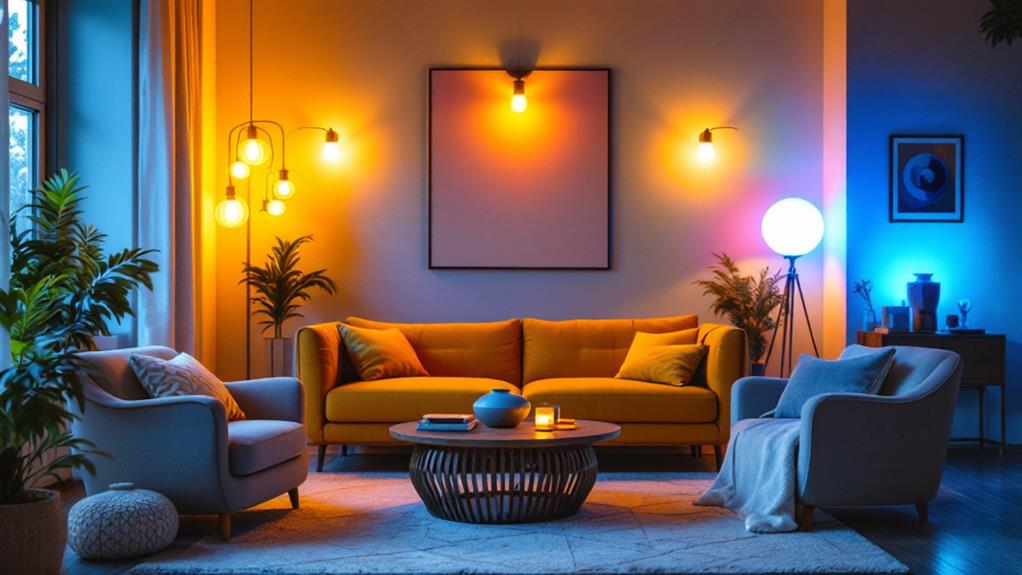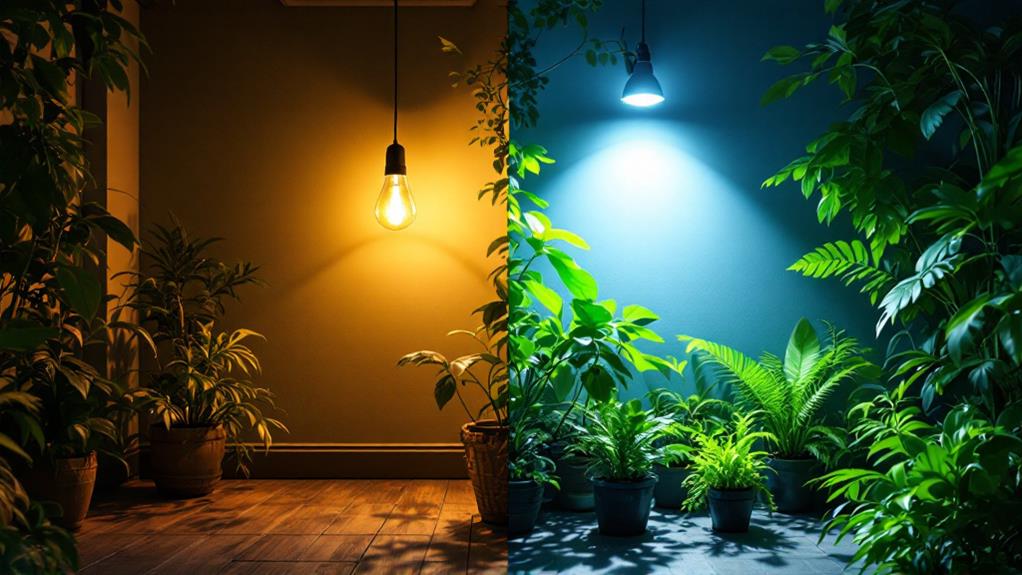
Understanding Lumens: Brightness vs. Energy Consumption
Understanding lumens is essential for evaluating lighting efficiency, as lumens measure visible light output while watts indicate energy consumption. Traditional incandescent bulbs generate around 800 lumens at 60 watts, whereas LEDs can produce the same brightness using merely 8-12 watts. Such efficiency improvements result in significant energy savings and reduced electricity costs. The lumens-to-watt ratio, specifically higher in LEDs, signifies superior energy performance. Selecting lighting based on lumens rather than watts enhances illumination quality while minimizing environmental impact. This approach emphasizes not just energy efficiency but also contributes to sustainable lighting practices in modern settings. Discover more about optimizing your lighting choices.
Key Takeaways
- Lumens measure brightness, while watts measure energy consumption; higher lumens per watt indicate better efficiency.
- LEDs provide 800 lumens with 8-12 watts, compared to 60 watts for incandescent bulbs.
- Focusing on lumens ensures desired brightness with minimized energy use.
- LED bulbs offer up to 80% energy savings over traditional incandescent lighting.
- Understanding lumens allows for optimal lighting functionality and energy conservation.
Lumens Defined
In the domain of lighting technology, lumens serve as the definitive metric for quantifying the visible light emitted by a source. Lumen measurement enables an accurate assessment of brightness by considering the total quantity of visible light, as opposed to energy consumption metrics like watts.
This distinction is critical in understanding lumen perception, as it directly correlates to how humans perceive the intensity of light in various environments. For instance, a 100-watt incandescent bulb, traditionally perceived as bright, emits approximately 1600 lumens, whereas a 60-watt bulb emits about 800 lumens.
The shift to LED technology underscores the importance of lumens. LEDs can produce equivalent brightness with considerably lower wattage; a 6-watt LED can produce the same 800 lumens as a 60-watt incandescent bulb.
This efficiency highlights the importance of lumen measurement in modern lighting solutions, enabling consumers to make informed decisions that optimize both lighting functionality and energy efficiency.
Brightness vs. Energy
Understanding the relationship between lumens and energy consumption is pivotal in the domain of modern lighting technology. Lumens measure the total visible light output, while watts quantify the power used. Analyzing these metrics reveals that traditional incandescent bulbs, such as a 60-watt bulb generating approximately 800 lumens, are less efficient compared to LEDs, which achieve similar brightness using only 8-9 watts. This efficiency is quantified by lumens per watt, where higher values indicate superior energy performance.
Transitioning from watt-based to lumen-based purchasing empowers consumers to select bulbs based on desired brightness rather than energy consumption, leading to significant reductions in electricity usage. This paradigm shift is essential as lighting technology advances, promising cost savings and sustainability.
An informed choice also considers color temperature, which influences light quality. For instance, LEDs offer a range of color temperatures, enabling customization of lighting environments to enhance mood and productivity.
Ultimately, adopting lumen-based evaluations facilitates not only energy conservation but also improvements in light quality. This approach underscores the importance of understanding lumens in achieving ideal lighting solutions, balancing brightness, energy efficiency, and the overall ambiance created by varying color temperatures.
The Lighting Facts Label
The Lighting Facts label serves as a standardized information panel, mandated by the Federal Trade Commission (FTC), providing fundamental data to consumers regarding light bulb performance. It encompasses several key label components that enable consumers to make informed decisions.
The label prominently features the brightness of the bulb, expressed in lumens, facilitating direct comparison of light output across different products. Additionally, it includes an estimated yearly energy cost, allowing consumers to evaluate the long-term financial implications of their lighting choices based on energy consumption patterns. This cost estimation is essential for making economically sound purchasing decisions.
Another critical aspect of the Lighting Facts label is the indication of the bulb's lifespan. This component provides consumers with a clear understanding of how long a bulb is expected to last, aiding in the planning of future replacements and maintenance.
Moreover, the label presents the light appearance through correlated color temperature (CCT) in Kelvin, offering insights into the color quality of the light emitted.
Consumer Benefits:
- Brightens comparison: Lumens detail guarantees accurate brightness evaluation.
- Calculates cost: Energy cost aids in financial decision-making.
- Predicts durability: Lifespan information enhances purchase longevity.
Lumens and Energy Savings
Switching from incandescent bulbs to LED lights marks a significant advancement in energy efficiency, primarily due to the role of lumens in determining brightness. Unlike traditional incandescent bulbs, which consume higher wattage to produce the same lumens, LED lights offer substantial energy savings.
LEDs can reduce energy consumption by up to 80%, as they generate the same brightness with only 8-12 watts compared to the 60 watts required by incandescent bulbs to produce 800 lumens. This efficiency is a key LED advantage, reflecting a significant reduction in energy use and cost over time.
Analyzing cost comparisons, it becomes apparent that LEDs, despite a higher initial purchase price, are more cost-effective in the long run. Their ability to convert more energy into light rather than heat results in lower electricity bills and reduced environmental impact.
By focusing on lumens rather than wattage when selecting lighting solutions, consumers can guarantee ideal brightness while minimizing energy expenditure. This shift not only supports financial savings but also contributes to a reduced carbon footprint.
Consequently, understanding lumens and their relationship to energy consumption is vital for making informed, sustainable lighting choices.
Comparing Lighting Technologies
In the context of lighting technology, efficiency is primarily characterized by the lumens-to-watt ratio, with modern LED bulbs achieving up to 100 lumens per watt compared to the 15 lumens per watt of traditional incandescent bulbs.
This disparity in efficiency is further highlighted by the fact that a 60-watt incandescent bulb produces 800 lumens, whereas an LED equivalent requires merely 8-12 watts to deliver the same brightness.
Consequently, as lighting technology advances, the emphasis on lumens as a measure of output over wattage underscores the shift towards more energy-efficient and sustainable lighting solutions.
Efficiency of Modern Bulbs
Frequently, the efficiency of modern lighting technologies is evaluated by comparing their energy consumption and luminous efficacy. LED advantages are prominently highlighted in this scenario due to their remarkable energy innovations.
For instance, modern LED bulbs can produce 800 lumens of brightness while consuming only about 9 watts, whereas traditional incandescent bulbs require approximately 60 watts for the same light output. This represents a significant reduction in energy consumption.
Compact Fluorescent Lamps (CFLs) are another example, achieving 800 lumens with about 13-15 watts, still a marked improvement over incandescent technology. The efficacy of LEDs, rated at about 80-100 lumens per watt, starkly contrasts with the 10-17 lumens per watt typical of incandescent bulbs, underscoring the superior efficiency of modern lighting solutions.
Additionally, the lifespan of LED bulbs, averaging around 15,000 hours, greatly exceeds the 1,000-hour lifespan of incandescent bulbs. This longevity results in reduced replacement costs and waste.
As lighting technologies continue to evolve, the efficiency gap widens, further positioning LED and other modern bulbs as cost-effective and environmentally sustainable options.
Consider the following benefits:
- Lower energy consumption
- Higher luminous efficacy
- Extended lifespan and reduced waste
LED vs. Incandescent Brightness
When evaluating the brightness of LED versus incandescent lighting technologies, it becomes evident that LED bulbs offer substantial advantages regarding energy efficiency and lumen output.
LED advantages are highlighted by their ability to produce equivalent or greater brightness levels at greatly reduced energy consumption. For instance, an LED bulb can produce 800 lumens, comparable to a 60-watt incandescent bulb, while consuming only 8-9 watts. This contrasts starkly with the incandescent drawbacks, where a 100-watt bulb might emit 1600 lumens, a feat easily matched by LEDs using just 15-20 watts.
The efficacy of LEDs is further underscored by their lumens per watt ratio, which can exceed 100, compared to the mere 15 lumens per watt typical of incandescent bulbs.
This marked difference in efficiency translates to potential energy savings of up to 80% when shifting from incandescent to LED lighting, without compromising brightness. Understanding lumen output is essential for accurately comparing these technologies, as it demonstrates how LEDs maintain high light quality with reduced wattage.
These factors underscore the compelling case for adopting LED lighting, considering both the environmental impact and cost-effectiveness over time, compared to traditional incandescent bulbs.
Calculating Lumens and Watts
Calculating lumens and watts involves understanding the distinct roles each plays in lighting efficiency. Lumens measure the brightness output of a light source, while watts quantify the energy consumption required to produce that brightness.
To effectively calculate and compare these two parameters, the lumens formula and wattage conversion are essential tools. For instance, the formula Watts = Lumens x 0.001496 provides a direct method for converting lumens to watts, enabling consumers to gauge the energy requirements for a specific level of illumination.
The relationship between lumens and watts is critical in evaluating lighting efficiency across different bulb technologies. Traditional incandescent bulbs typically deliver about 15 lumens per watt, whereas modern LED bulbs achieve a remarkable 80-100 lumens per watt. This efficiency translates into lower energy consumption and cost savings for the same brightness level.
Here are key points to reflect on:
- Comparative Analysis: A 60-watt incandescent bulb emits roughly 800 lumens, while an LED bulb requires only 8-9 watts for the same output.
- Energy Efficiency: Understanding lumens per watt helps in selecting energy-efficient lighting.
- Practical Application: Use the lumens formula to calculate wattage and optimize energy consumption.
These insights empower consumers to make informed lighting choices.
Choosing the Right Lumens

Selecting the appropriate lumen output is a vital step in achieving ideal lighting for any space. To optimize illumination, it is necessary to determine the primary purpose of the lighting—whether for task lighting, ambient lighting, or accent lighting.
Task lighting in areas such as kitchens and workspaces necessitates higher lumen levels, specifically 70-80 lumens per square foot, to guarantee sufficient brightness for detailed activities. Conversely, ambient lighting in living rooms and bedrooms can be adequately achieved with lower lumen levels, typically ranging from 10-20 lumens per square foot, fostering a comfortable and relaxing atmosphere.
Room size and layout are significant factors influencing the selection of lumen levels. Larger spaces require higher lumen outputs to achieve uniform light distribution and prevent dark corners.
It is also essential to take into account personal preferences and the color temperature of the light source, as these factors greatly affect the perceived brightness and ambiance of a room. Color temperature can range from warm to cool, impacting the mood and functionality of the space.
Therefore, an analytical approach encompassing these variables will facilitate the selection of appropriate lumens, guaranteeing both functional and aesthetically pleasing lighting solutions.
Environmental Impact of Lighting
Shifting to energy-efficient lighting solutions, such as LED bulbs, plays an essential role in minimizing the environmental impact of lighting. Sustainable lighting practices not only address the pressing need for eco friendly choices but also greatly reduce electricity consumption.
LED lighting is pivotal in this change, offering a substantial reduction in carbon emissions and a decreased environmental footprint relative to traditional incandescent bulbs. By switching to LED bulbs, households can achieve up to 75% savings on energy costs, thereby alleviating energy demand and furthering financial savings.
The long lifespan of LED bulbs, extending up to 25,000 hours, also contributes to environmental sustainability by reducing waste from frequent bulb replacements. This longevity aids in minimizing the ecological footprint associated with lighting.
Collectively, the adoption of energy-efficient lighting can prevent millions of tons of greenhouse gas emissions annually, thereby supporting global sustainability efforts.
The projected impact of this change is substantial:
- Energy consumption in the U.S. is expected to decrease by approximately 348 terawatt-hours by 2027.
- This reduction is equivalent to the yearly electricity consumption of around 30 million homes.
- Such eco friendly choices underscore the critical role of sustainable lighting in environmental conservation initiatives.
Frequently Asked Questions
What Is 470 Lumens Equal to in Watts?
470 lumens typically equates to approximately 7-9 watts for LED bulbs, demonstrating LED's superior efficiency. This watt equivalence contrasts starkly with incandescent bulbs, where 470 lumens generally requires 40 watts, underscoring the importance of understanding lumens definition in lighting.
Are Lumens a Measure of Energy Consumption?
Lumens are not a measure of energy consumption; they quantify brightness perception. Lumen efficiency is essential for evaluating light output relative to energy use, allowing consumers to assess lighting options based on visible brightness rather than wattage alone.
What Is 500 Lumens Equal to in Watts?
500 lumens equates to varying wattage based on bulb type. In lumens comparison, incandescent bulbs use about 40 watts, CFLs require 13-15 watts, and LEDs consume only 6-9 watts, highlighting the superior lighting efficiency of LEDs.
Does More Lumens Mean More Energy?
Increased lumens signify enhanced brightness perception, yet they do not inherently indicate higher energy usage. Efficiency comparison reveals that modern LEDs deliver more lumens per watt, consequently achieving superior brightness with reduced energy consumption compared to traditional incandescent bulbs.
Conclusion
In summary, understanding lumens is vital for optimizing both brightness and energy consumption in lighting solutions. The distinction between lumens and watts is essential for evaluating lighting efficiency, with lumens measuring brightness and watts indicating energy use. The Lighting Facts Label aids consumers in making informed choices, promoting energy savings and reduced environmental impact. Comparing lighting technologies further highlights the importance of selecting appropriate lumens for specific applications, thereby enhancing energy efficiency and contributing to sustainable lighting practices.



Leave a Reply